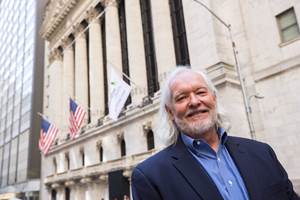The Future of Biopolymers Looks Bright
NatureWorks’s 2016 conference showed that innovation in biopolymer technology will continue to thrive.
NatureWorks’s 2016 conference showed that innovation in biopolymer technology will continue to thrive.
Despite some pundits who opined that low oil prices would stop growth in biopolymers in its tracks, it appears that this has not come to fruition.
In fact, biopolymers are already playing a broader role in the industry: as base materials, as blends/alloys, as specialty additives, and as 3D printing filaments. This just one of the many things I learned by attending the 5th edition of Innovation Takes Root (ITR) in Orlando, Fla., a three-day event sponsored by manufacturer of Ingeo PLA NatureWorlks LLC, Minnetonka, Minn.
Global Ingeo PLA channel partners from the entire bioplastic value chain came together to learn more about the innovations emerging in a host of markets—from 3D printing to flexible and rigid packaging to durable goods. PLA is a bioplastic made up of long molecular chains of the polymer polylactide derived from naturally-occurring plant sugars, at least so far.
But change and innovation are underway for PLA, and its feedstocks, and biopolymers in general. Take for instance two key announcements that were made right around the time of this conference:
• NatureWorks opened a $1-million, 8,300-sq.ft. laboratory at its world headquarters. The new lab represents the latest milestone in a multi-year program to commercialize a fermentation process for transforming methane—a potent greenhouse gas, into the PLA building block lactic acid. The methane-to-lactic acid research began in 2013 as a joint effort between NatureWorks and Calysta Energy, Menlo Park, Calif., to develop a fermentation biocatalyst.
In 2014, laboratory-scale fermentation of lactic acid from methane utilizing a new biocatalyst was proven, and the U.S. Department of Energy awarded $2.5 million to the project. The lab’s opening represents a major step toward commercial reality.
The aim is to have a pilot plant in place within a three-to-six year time frame. Commercial success of this technology would diversify NatureWorks away from reliance on agricultural feedstocks, and with methane as feedstock, it could structurally lower the cost of producing Ingeo. The company envisions a future where greenhouse gas is transformed into Ingeo-based products ranging from compostable food serviceware, to film for wrapping fresh produce and deli packaging, to durable products such as computer cases and filaments for 3D printers.
• Metabolix, Cambridge, Mass., has signed a memorandum of understanding with Korea’s CJ Cheiljedang Corp. (CJ) for a strategic commercial manufacturing arrangement for specialty PHAs, including its newly launched amorphous PHA (a-PHA)—for use as performance additives in PLA and PVC. Which brings its vision for large-scale PHA production that much closer.
Under the agreement, CJ will fund, construct and operate a 20-million/lb PHA production unit at its Fort Dodge, Iowa facility, based on Metabolix’s PHA technology. The facility is operated by CJ’s division CJ BIO, a world leader in microbial fermentation based R&D and manufacturing for a range of amino acids, including lysine, as well as nucleotides. Production startup is anticipated within the next 18-24 months. In turn, Metabolix will buy the specialty PHAs produced at the facility, and market and sell the material to its commercial customers. The team also expects to define a framework for longer-term expansion of the collaboration for larger-scale PHA production and related commercial activities.
The conference was concluded with a terrific presentation by NatureWorks’ president & CEO Marc Verbruggen (pictured below). Among the key takeways:
• Achieving sufficient economy of scale has been a critical factor.
• Diversifying product mix and markets has been key. By 2015, Ingeo PLA markets included food service wear, films, fibers, rigid packaging, durable goods, and performance chemicals.
• During oil drop-off, Ingeo sales increased in five of the company’s six businesses.
• A key goal is to develop a one-step process of turning “greenhouse gas” into PLA, which would significantly reduce feedstock costs.
• New multifunctional barrier structures allow the rethinking of flexible multilayer structures—with some packaging moving from fossil-based three-film structures to 100% biobased two-film structures.
• New advanced PLA injection molding compounds and alloys will be positioned as a functional alternative to ABS in durable applications.
Search for more of NatureWorks Ingeo PLA and Metabolix’s PHA biopolymers on PT’s materials database.

Related Content
Why Are They Blending Biopolymers?
A sit-down with bioplastic producer Danimer Scientific showed me there are more possible answers to that question than I had previously thought.
Read MoreAt NPE2024, Follow These Megatrends in Materials and Additives
Offerings range from recycled, biobased, biodegradable and monomaterial structures that enhance recyclability to additives that are more efficient, sustainable and safer to use.
Read MoreHonda Now Exploring UBQ’s Biobased Material Made from Unsorted Household Waste
UBQ is aiming to expand its reach for more sustainable automotive parts as well as non-automotive applications.
Read MoreHow to Extrusion Blow Mold PHA/PLA Blends
You need to pay attention to the inherent characteristics of biopolymers PHA/PLA materials when setting process parameters to realize better and more consistent outcomes.
Read MoreRead Next
Lead the Conversation, Change the Conversation
Coverage of single-use plastics can be both misleading and demoralizing. Here are 10 tips for changing the perception of the plastics industry at your company and in your community.
Read MoreProcessor Turns to AI to Help Keep Machines Humming
At captive processor McConkey, a new generation of artificial intelligence models, highlighted by ChatGPT, is helping it wade through the shortage of skilled labor and keep its production lines churning out good parts.
Read More






.png;maxWidth=300;quality=90)

















